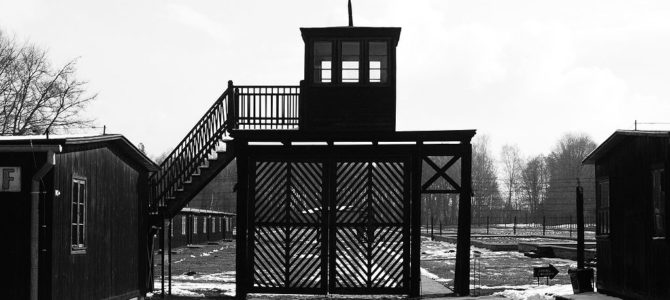
This article includes descriptions of torture and murder.
Former Schutzstaffel (SS) guard Bruno Dey is on trial in Hamburg, Germany, charged as an accessory to 5,230 murders that took place in the Stutthof concentration camp between August 1944 and April 1945. Because his alleged crimes occurred when Dey was just 17, the 93-year-old is being tried in juvenile court.
Dey’s trial is part of Germany’s renewed effort to bring those complicit in Nazi genocide to justice for their crimes. Prosecutors admit he was a “small wheel in the machinery of murder,” so Dey faces six months to 10 years in prison if convicted.
Around 65,000 of the 110,000 prisoners held in Stutthof were killed there, including 28,000 Jews. They died from overwork, disease, or torture, being hung or shot, or being killed by means of injection with phenol and gasoline, or with Zyklon B gas.
Dey Has Changed His Story
During his extensive pretrial testimony, Dey admitted he was aware of the purpose of Stutthof’s gas chamber. He also claimed to have heard screams from within the gas chamber, and had witnessed bodies being transported to the crematoria. He explained he understood the Jews in the camp “hadn’t committed a crime, that they were only in [Stutthof] because they were Jews.”
Dey’s testimony in court on October 25 told an amended story. When the judge asked what he had witnessed from his position on the watchtower, Dey responded “people were led in, into the gas chamber…the door was locked.” After admitting hearing screams and banging noises from inside the chamber, Dey stated he “didn’t know that they were being gassed.” He likewise admitted only to hearing “rumors” that camp prisoners included Jews.
Dey also did much obfuscating during his first day of testimony on October 21. After apologizing to Stutthof victims, he let loose with maddening claims that he has long been haunted by “images of misery and horror,” and lamented how his trial is “‘destroying’ the autumn years of his life.”
At one point, Dey attempted to draw comparison between himself undressing for a military physical and camp prisoners being forced to undress to be inspected by guards. His self-pity shows a horrifying lack of compassion for the victims of Nazi crimes at Stutthof.
New Legal Precedent Enabled Dey’s Trial
In the aftermath of World War II, six million Jews, two-thirds of the pre-war European Jewish population, had been killed by the Nazi architects and enablers of genocide. Between 1945 and 1949, the Allies tried 199 high-ranking Third Reich officials in Nuremburg, convicting 161, and sentencing 37 to death. Allied forces had “captured millions of documents during the conquest of Germany,” allowing prosecutors to present “3,000 tons of records at the Nuremberg trial.”
Both a divided and a reunified Germany struggled to hold the remaining Nazi criminals accountable. The extensive Nazi paper trail has not prevented individuals from “deflect[ing] their responsibility for the killings.”
A breakthrough arrived in 2011, when prosecutors brought charges against 91-year-old John Demnjanjuk, a naturalized American citizen who worked during the war as a guard at the Sobibor death camp. As a guard, prosecutors argued, Demjanjuk had been an enabler of mass killings, making him an accessory to 28,000 murders.
Although he denied his guilt, Demjanjuk was convicted. The precedent established was tenuous, however, as Demjanjuk’s conviction was never entered into legal records because he died while awaiting appeal.
In 2015, 95-year-old Oskar Gröning, the “bookkeeper of Auschwitz,” was tried on 300,000 counts of accessory to murder. Gröning, who admitted he was “beyond question…morally complicit,” was convicted, and sentenced to four years in prison. Gröning nonetheless appealed his conviction, which was upheld by federal courts. He died awaiting a second appeal.
Finding Nazis Who Disappeared After the War
In the aftermath of these and a number of other successful convictions, the German Central Office of the State Justice Administrations for the Investigation of National Socialist Crimes began looking into guards at other Nazi death camps, as well as former members of Hitler’s Einsatzgruppen, mobile killing squads that committed mass murder of Jews throughout Eastern Europe. Stutthof marks the first concentration camp where the German Central Office has focused its efforts.
In 2016, the office announced it had located eight individuals who worked at Stutthof after it was brought into the German concentration camp system in 1941. Dey is the second of these individuals to be brought up on charges.
Former Stutthof SS guard Johann Rehbogen was tried in a Münster, Germany juvenile court for accessory to murder in November 2018. The 94-year-old wept at the trial’s opening, but obstinately claimed that, while he knew of “mass cremation of corpses,” he was unaware of killings within the camp, and knew nothing of the camp’s gas chamber.
Although Rehbogen never issued an apology to Stutthof’s victims, he made a statement admitting “moral responsibility.” Because of his failing health, Rehbogen’s trial ended without resolution last December.
Given his age, Dey’s trial could likewise end without a clear conviction. More important than any precedent or prison sentence is the possibility to secure additional facts about the Nazi genocide for future generations, and to provide closure to the survivors and families who remain.
“We are giving the chance to the accused and the witnesses to tell us their stories – and not just to the media,” explained Jens Rommel, from the German Central Office. “They are telling them in a courtroom.”
American Survivor Testifies in Dey’s Case
A senior Nazi hunter at the Simon Weisenthal Center located two dozen Stutthof survivors to be co-plaintiffs in the Stutthof trials. Among them is 90-year-old American Judy Meisel. In 2017, German investigators traveled to Meisel’s Minneapolis home to record her testimony about the Stutthof guards.
Meisel was transferred from Auschwitz to Stutthof with her sister, Rachel, and mother, Mina, in summer 1944. There, two camp guards tore out her hair by hand, using it for a child’s doll. Meisel and other female prisoners were forced to undress before being beaten by a camp guard. When she was caught swallowing a note passed from the men’s camp, the camp commandant used pliers to pull out her nails.
Meisel nearly perished in Stutthof’s gas chamber. As guards led a group of Jews, which included Meisel and her mother, into the chamber on November 21, 1944, one guard yelled at Meisel to get out. While her mother remained in the chamber, Meisel ran back to her barracks, preserving her life.
With her sister, Meisel manufactured a series of incredible escapes to secure their ever-more-unlikely survival. When the girls were liberated, 16-year-old Meisel weighed just 47 pounds.
Meisel became a civil rights activist in the United States, and still speaks publicly of her experience to “inspire others to stand up to hatred, bigotry and prejudice.” Unable to travel for Rehbogen’s and Dey’s trials, her grandson, Ben Cohen, has attended both in her stead.
“I’ve realized that her story is actually my story,” Cohen told reporters. “I actually have a role to play.”
For the World, the Trials Matter
Like Cohen, we all have a role to play. The antisemitism that caused the Nazi genocide nearly 75 years ago has not retreated, but resurfaced with its dangerous offshoot of Holocaust denial. The phenomenon is taking place not just around the world, but also at home. In 2018, the Anti-Defamation League recorded 1,879 incidents of antisemitic hate across the United States. 
Sunday marked the passage of one year since a white supremacist killed 11 Jewish worshipers from three different congregations which used Tree of Life Synagogue in Pittsburgh, Pennsylvania to practice their faith. On April 27, a man killed one Jewish congregant and attempted to kill three others at Chabad of Poway, in California.
As of September, antisemitic hate crimes in New York City had increased by 63 percent from 2018, and included acts of vandalism as well as violence targeting Orthodox Jews. In Boca Raton, Florida, a principal was reassigned in June for informing a parent he could not prove the Holocaust was a “factual, historical event.”
In such an environment, the trials of former Nazis matter. Dey’s twice-weekly, two hour sessions of questioning demonstrate to the watching world the face, and the consequences, of hatred. They are a warning that our actions, even of complicity or silence, have consequences.
For the victims of the past, and for future generations, the world must make an example of perpetrators like Rehbogen, Dey, Göring, and Demnjanjuk. No amount of passing time can diminish the harm done by accomplices to genocide.
Many believe Dey will be the final Nazi to come under scrutiny for his wartime actions. The population of victims and perpetrators is aging. Soon, the torch will pass to the rest of us to recall the Holocaust. We must prepare to bear the heavy burden of protecting the past. To do so will require putting our politics aside and presenting a united front against Holocaust denial, and the hateful pseudoscience of antisemitism.









